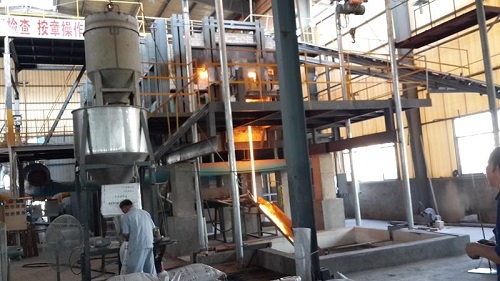[Zhongbo.com] For the regenerative horseshoe flame melting furnace, a fire change operation is required every half hour or so during normal operation to change the universal direction of the intake and exhaust of the regenerator. When the fire is changed, the temperature of the melting part and the regenerator of the kiln will fluctuate. The temperature change in the upper part of the regenerator in the normal operation of the kiln is approximately sinusoidal and cosine, and the temperature change of the melting part is approximately jagged.
If in a fire change cycle and another fire change cycle, the temperature change between the melting section of the kiln and the upper part of the regenerator is quite different from the normal operation, except for the gap wear and the etchover failure of the cross wall. There may also be a problem with the failure of the switch base. This fault is relatively hidden and difficult to detect, often resulting in analysis and judgment errors.

The joint between the exchanger base and the flue refractory should be kept airtight, but due to the difference in material expansion and the erosion of the high temperature airflow, etc., the joint between the steel base of the exchanger and the refractory material is often point A or B. The point creates a gap. If there is a gap at point A, when the jumper is placed on the left side and the right side of the flue is filled with gas or air, some gas or air is short-circuited from the gap at point A and directly enters the total flue to be pumped away, causing gas into the furnace. Or the air is reduced, so that the furnace temperature is lowered when the fire is changed on the side, and if a gap is generated at point B, the gas or air is short-circuited, thereby causing a temperature difference of the fire. In this case, the temperature difference of the fire is different from the temperature difference caused by the gap between the regenerator and the cross wall of the regenerator. The temperature difference caused by the gap of the cross wall is accompanied by an abnormal increase in the temperature of the lattice of the regenerator, and the gap of the gap of the exchanger base is short-circuited. The temperature difference of the fire change, the temperature of the regenerator is not changed much, and only the increase of the total flue temperature is a clear sign. When the temperature change curve of the regenerator and the melting part in the actual operation of the kiln is compared with the temperature change trend of normal operation, it can be judged where the abnormal situation of the kiln occurs.
If there is a gap short circuit in the base of the exchanger, the solution is to stop the transmission of gas or air. After the temperature of the flue is lowered, the plug is blocked to block the gap between point A or point B, and the temperature difference of the fire can be eliminated.
100% cotton workwear fabrics combine all the comfort of cotton with the quality and durability needed for tough working clothes..Available in a wide range of colours and weights from 230gsm to 375gsm, our 100% cotton fabrics are also Industrially launderable...
- Low Shrinkage
- Industrial Washing
- high Colour Fastness
- Comfort

Durable, lightweight and easycare...with water repellent finish.
100% polyester fabrics offer high strength, excellent colour retention properties, comfort for the wearer and are industrially launderable..
Conventional Fabric,Abrasion Conventional Fabric,Nylon Conventional Fabric,Polyester Conventional Fabric
Wujiang Bonheur Special Textile Co.,Ltd. , https://www.bonheurtex.com
![<?echo $_SERVER['SERVER_NAME'];?>](/template/twentyseventeen/skin/images/header.jpg)